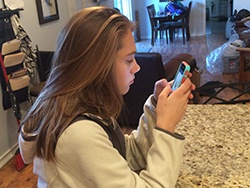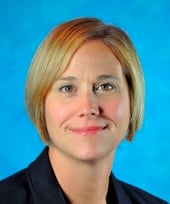Today we’re sharing insight from guest blogger, Erin Cressy, President & CEO of Cressy Consulting. We hope you enjoy Erin’s wisdom and perspective.
 “Mom, it’s not like it’s the 1990’s anymore!” I was taken aback as these words were uttered to me a few months ago by my twelve year old daughter, Ava.
“Mom, it’s not like it’s the 1990’s anymore!” I was taken aback as these words were uttered to me a few months ago by my twelve year old daughter, Ava.
I had opened the door to her room to see what she was doing; the voices I heard coming from there were perplexing to me. As I cracked the door open and peered in an interesting scene played out in front of me: Ava was busy getting ready for school the following day, laying out her outfit, packing up her back pack, gathering her clothes for cross country practice – all while facetiming with her good friend Audra.
Ava’s iPod was in the middle of the floor, with Audra’s face clearly visible, while she walked about her room and chatted with Audra about her teachers, her homework, and the new friends she was making in 6th grade. I watched for a few seconds and then walked in, saying hello to Audra and handing Ava the form she needed me to sign.
Then I couldn’t resist asking a few questions about what they were doing, “Ava, why are you face-timing Audra while you’re walking around the room? She can’t even see you. Why don’t you just finish what you’re doing and then give her a call?”
It was this generational misstep which triggered her response, “Mom, it’s not the 1990’s anymore!” My reaction was a bit defensive: “Oh yeah, Ava, like the 1990’s were sooo long ago!”
It was strange to me that Ava was talking to her friend and not even looking at her. She was loud as she walked around her room and she was clearly focused on more than the conversation she was having; which is why I encouraged her to finish her tasks and then talk to Audra. But, when I thought further about this interaction it struck me that this scene was very similar to my own behaviors at age twelve.
I distinctly remember pulling the twisty phone cord as far as it would reach so I could sneak the kitchen phone through the office door and be as far away from my parents as possible. I wanted privacy so I could re-hash the day’s events with my best friend, Carrie. We talked about the same things Ava did. We talked for hours, about nothing much of substance but it mattered greatly to me at the time.
On the face of it, the generational differences between Ava and me are clear: technology is a second (if not first) language for Ava. She has never even used a phone that actually had to stay connected to the receiver with a phone cord. The ability to see someone while talking is a given. Having technology integrated into almost every aspect of daily life is the status quo. Why wouldn’t she FaceTime with Audra while also getting her things packed for school the next day?
My interaction with Ava mirrors a lot of the experiences and emotional responses we have when working across the generations in our businesses and organizations. As human beings we are drawn to those similar to us – people with similar backgrounds, hobbies, values, and work habits. It’s easy and comfortable to work with our ‘own kind.’ When we work across differences, whether that be differences in age, workstyle, race, gender, educational background, etc., we often find ourselves responding to such differences in a negative way - sort of like my need to defend the 1990’s.
What we have to do is look a little deeper to see the similarities, the shared values that we are operating from. As for Ava, she values close relationships with her friends. She has the need to share the experiences of her day with the people who matter most to her. She wants to have fun, do well in school and be a good friend. Pretty much the same things I valued at age twelve, and still do today. It just so happens she does it via FaceTime, while I used the kitchen phone with the super-long, stretchy phone cord.
One of the best books I’ve read in a long time is, “Sticking Points: How To Get 4 Generations Working Together In The 12 Places They Come Apart,” by Haydn Shaw. Shaw goes into great detail explaining the ‘ghost stories,’ or shared historical experiences, that have shaped each generation. Things like the Great Depression, the invention of TV, an increase in divorce rates, and 9-11. He explains the value of the generations learning about one another so we can better understand the ‘why’ behind our perceived differences rather than just the ‘what’ of what those differences are. When we work to understand the ‘why’ we can get to the place of finding common ground, of seeing our differences and working through them, of leading through generational diversity, not simply managing it as a necessary evil.
Here’s a key question to consider when faced with generational roadblocks in your organization: Is this issue about a generational preference or is it a business imperative? Take the example of me and Ava. As the parent I could have taken her iPod and told her to finish what she was doing before she talked to Audra. This response would have been triggered by my generational preference for a certain style of communication. However, realizing there was no ‘business imperative’ (or more like ‘parenting imperative’ - i.e. there was no harm done by allowing her to continue communicating this way) I chose to let the conversation continue. We were both happier as a result.
What’s The Risk?
Chances are you’re already seeing risks of failing to lead through generational differences. Struggles such as an inability to recruit or retain employees (especially from the Millennial generation), low employee engagement, and higher levels of workplace conflict. The fact is, the multi-generational workforce is here to stay and the Millennials will continue to have a greater and greater impact on our organizations. Take some time to read Shaw’s book and arm yourself with the knowledge necessary to lead your organization through generational differences. In doing this you will not simply lesson the negative outcomes, you will leverage one of your company’s greatest assets – your employees.
This content was written and shared by guest blogger, Erin Cressy.
 Erin Cressy is the President/CEO of the consulting firm, Cressy Consulting, which is based in South Bend, Indiana. With over 15 years of experience in the fields of diversity and leadership Erin blends her academic expertise with her business savvy to design and lead initiatives that create lasting change for individuals and organizations. Erin utilizes consulting, training, professional coaching and facilitation skills to support organizations in leveraging talent and creating a ‘culture of inclusion.’
Erin Cressy is the President/CEO of the consulting firm, Cressy Consulting, which is based in South Bend, Indiana. With over 15 years of experience in the fields of diversity and leadership Erin blends her academic expertise with her business savvy to design and lead initiatives that create lasting change for individuals and organizations. Erin utilizes consulting, training, professional coaching and facilitation skills to support organizations in leveraging talent and creating a ‘culture of inclusion.’
Erin holds a Ph.D. in Social Psychology; she is a current and founding board member of Girls on the Run Michiana and serves on the Society for Human Resource Manager’s Diversity Committee. Erin is also a member of the Board of Directors of Leadership South Bend/Mishawaka. In her personal life Erin appreciates being taught how to ‘lead through the generations’ on a daily basis by her three kids, Ava (12), Max (10) and Jackson (7).



